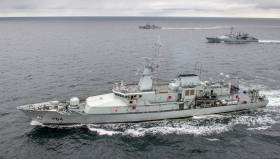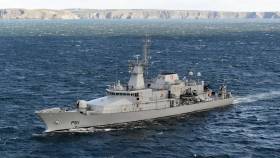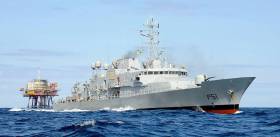Displaying items by tag: Public Tours
Newest Naval Service Vessel, LÉ George Bernard Shaw Opens to Public in Lough Swilly
Newest Naval Service vessel, LÉ George Bernard Shaw is to open to the public for guided tours this weekend (7th-8th December) at Rathmullan Pier in Lough Swilly, Co. Donegal.
Navy personnel of the latest offshore patrol vessel (OPV90) P60 class will be on hand during the tours held on Saturday between 1300-1600 and the following Sunday 1400-1600.
The crew will also be looking forward to taking part in the PolarPlunge Charity Event in aid of Special Olympics Ireland.
As Afloat previously reported the €67m newbuild took part in PASSEX training exercises with a Belgian Navy frigate in the the Irish Sea prior to a visit to Dublin Port in October.
It is more than a year ago when the fourth and final P60 class made a delivery voyage to Cork Harbour from UK shipyard, Babcock Marine & Technology's facility located in Appledore.
The shipyard in north Devon has since closed though there have been attempts to reopen.
Naval Service patrol ship LÉ Samuel Beckett (which this week detained a Portuguese fishing vessel) will be open for public tours when it is docked in the Port of Galway tomorrow, Sunday 25 August.
According to GalwayDaily, Naval Service crew will be taking members of the public on guided tours tomorrow from 10:00-12:00 in addition 14:00-17:00.
The LÉ Samuel Beckett is one of four new patrol vessels build for the Irish Naval Service in the past five years.
The Samuel Beckett the first to roll off the line in 2014, followed by the LÉ James Joyce in 2015, and the LÉ William Butler Yeats in 2016 and LÉ George Bernard Shaw last year.
For more including a photo of the detained Portuguese registered vessel for alleged breach of fishing regulations click here.
Ageing Naval Service Flaghip LÉ Eithne to Be Replaced By MRV, Opens to Public This Saturday
#NavalService - Following the Budget, Defence spending increases to €946m next year, this will include plans to replace Naval Service flagship LÉ Eithne with a new MRV, in the meantime the ageing ship opens to the public in Dun Laoghaire Harbour this Saturday, writes Jehan Ashmore.
LÉ Eithne, a unique Irish built vessel, dating to 1984, Afloat will have more to highlight as to why and on the replacement newbuild Multi Role Vessel. The use of a MRV will enchance certain capabilities that so far have alluded the Naval Service, notably in assisting UN mandated overseas missions. In addition to the EU's Operation Sophia where the Naval Service is also tasked in the humanitarian mission in the Meditterrean Sea and where LE. James Joyce is currently deployed.
As for the opening of LÉ Eithne this Saturday, the crew will provide guided public tours to take place between 10 am – 12 pm and in the afternoon between 2 pm – 4 pm. The flagship twinned with the harbour town, will berth at St. Micheals Pier (No 4 berth). This is located behind the Harbour Plaza, next to the former ferry terminal (for Holyhead) at the end of Marine Road.
Officially, LÉ Eithne is desigated as a helicopter patrol vessel (HPV), though the use of the ship's design for French built 'Dauphine' helicopters were rarely used and took place early in the career of the 1,900 tonnes flagship. The tour will include the large aft-deck where the use of helicopters took place next to the aircraft hanger. At the bow is mounted the main arnament, a Bofors 57mm Canon.
Afloat, adds the size of the fleet at 9 ships is the largest ever in the history of the Naval Service since foundation in 1946. The naval headquarters located on Haulbowling Island in Cork Harbour, is where LÉ Eithne was scheduled for a routine self-maintenance (see related story RMS Leinster, Dun Laoghaire) This is where the State's official RMS Leinster centenary commemorative ceremony that took place earlier this month.
On the following day of the RMS Leinster ceremony, the delivery from Babcock Marine in the UK of the €67m newbuild OPV90/P60 class LÉ George Bernard Shaw took place in Cork Harbour. This OPV is included in the fleet total, though the vessel has yet to be officially named and commissioned into service.
In recent years, LÉ Eithne as alluded above was deployed to the Mediterranean Sea under Operation Sophia tasked in the rescue mission of migrant / refugees.
Such challenging and also rewarding work given the circumstance faced of the flagship crew and fleetmates so far deployed, were recognised through a Civic Honour, the 'Freedom of Entry' which was bestowed by Dun Laoghaire-Rathdown County Council on behalf of Irish citizens and the EU.
The Freedom of Entry ceremony was held last year at the aforementioned Harbour Plaza located between the harbour and DLRCoCo's Town Hall on Marine Road.
Public Tours of Irish Sea Port of Barrow, England
#Ports&Shipping - The Irish Sea port of Barrow-in-Furness, England is to host public tours of the port next week on Tuesday, 2 October.
The tours running between 1pm-4pm will take around 2.5hrs and organised by Associated British Ports (ABP), the port owners. During the tours there will be an update on ABP's 25 year master plan for the port in Cumbria which Afloat reported on the port's 150th anniversary last year.
Commenting to Cumbrian Business Growth Hub, Carl Bevan, Divisional Port Manager said: “ABP are delighted to invite you to the Port of Barrow. It is hugely important to the county, region and country and has a rich 150 year history".
“The visit will showcase the Port and take you through our master plan which will see the Port continue to thrive for the next 150 years supporting vital works in the defence and energy sectors. The Port has an annual gross value add of £107m, supporting over 10,000 jobs in Cumbria alone”.
If interested in joining the tour, ABP request that you email Derek Armstring at [email protected] noting places are limited for this event (15 maximum).
LÉ Róisín Open to the Public This August Bank Holiday Weekend at Rathmullan Co. Donegal
#NavalService - L.E. Róisín, leadship of a pair of 'Róisín' or OPV80 class offshore patrol vessels will be open to the public in Co. Donegal this August Bank Holiday weekend.
The OPV is berthed at Rathmullan Pier, Lough Swilly where Naval Service crew yesterday provided guided tours of the 80m OPV. Further tours will be made available between 13:30 - 17:00 today and during tomorrow's Bank Holiday Monday.
Afloat had previously monitored L.É. Róisín during the annual Zeebrugge Navy Days, where foreign navies join those of their host, the Belgian Navy which has a base location within the commercial port that includes a ferry service to Hull in the UK. The three day event took place in late June early July in which public tours of the Irish Naval Service OPV took place.
L.É. Róisín was built by Appledore Shipyards, Bideford in the UK and was commissioned into service in December 1999. The same yard located in north Devon is now under different owners, Babcock Marine which is currently at the final stages of completing the newbuild OPV90 L.É. George Bernard Shaw, an enhanced version of the L.É. Róisín.
As for the construction of L.É. Róisín, Naval Service engineers stood by at all stages of the build.
The OPV80 class was built to a design that optimises patrol performance in Irish waters (which are the roughest in the world), all year round. For that reason a greater length overall (78.8m) was chosen, giving her a long sleek appearance and allowing the opportunity to improve the conditions onboard for her crew.
On board facilities include more private accommodation, a gymnasium and changing /storage areas for boarding teams.


























































